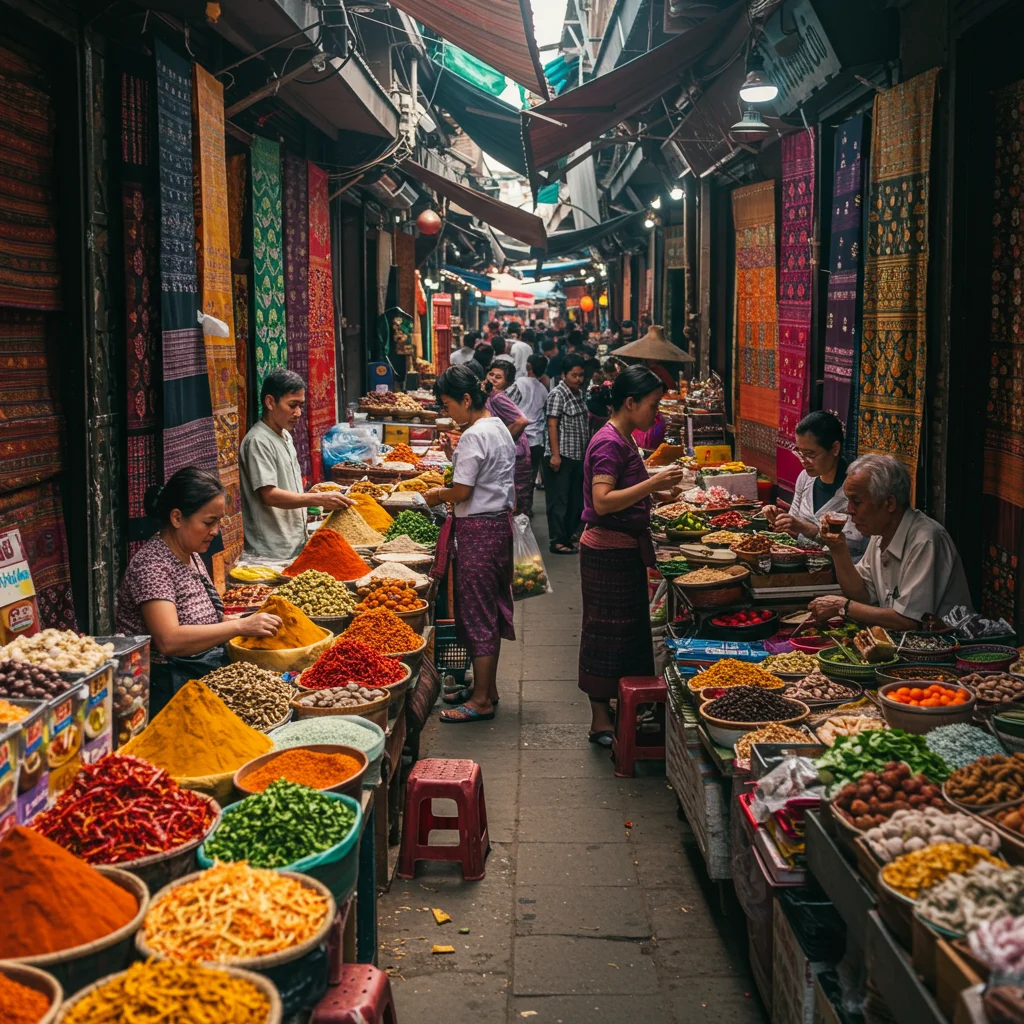Why Should You Shop Like a Local at Sampheng Market?
Shopping at Sampheng Market offers more than just a retail experience—it provides a window into the authentic rhythms of Bangkok life. By shopping like a local, we immerse ourselves in a sensory-rich environment filled with vibrant colors, bustling sounds, and tantalizing aromas. This market is where tradition meets the present, and every purchase comes with a story and a smile.
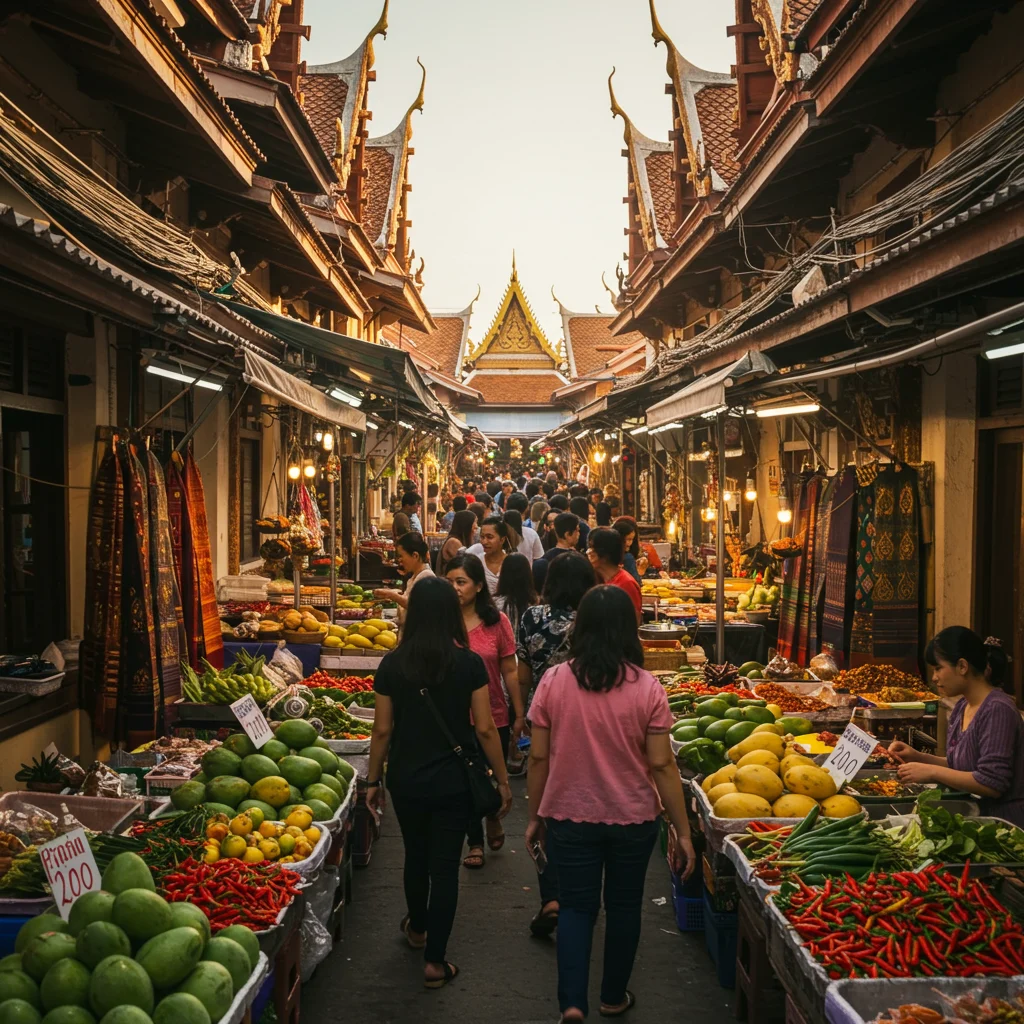
Local shopping not only supports small businesses but also allows us to find unique goods, often at a fraction of the price found in tourist hotspots. Exploring Sampheng as locals do helps us appreciate the true spirit of the city.
What Makes Sampheng Market Unique?
Sampheng Market stands apart thanks to its dense web of narrow lanes, an endless variety of products, and a lively atmosphere that pulses from sunrise to sunset. Here, the interplay of cultures—especially Thai and Chinese—creates a blend of merchandise and food that cannot be found elsewhere in Bangkok.
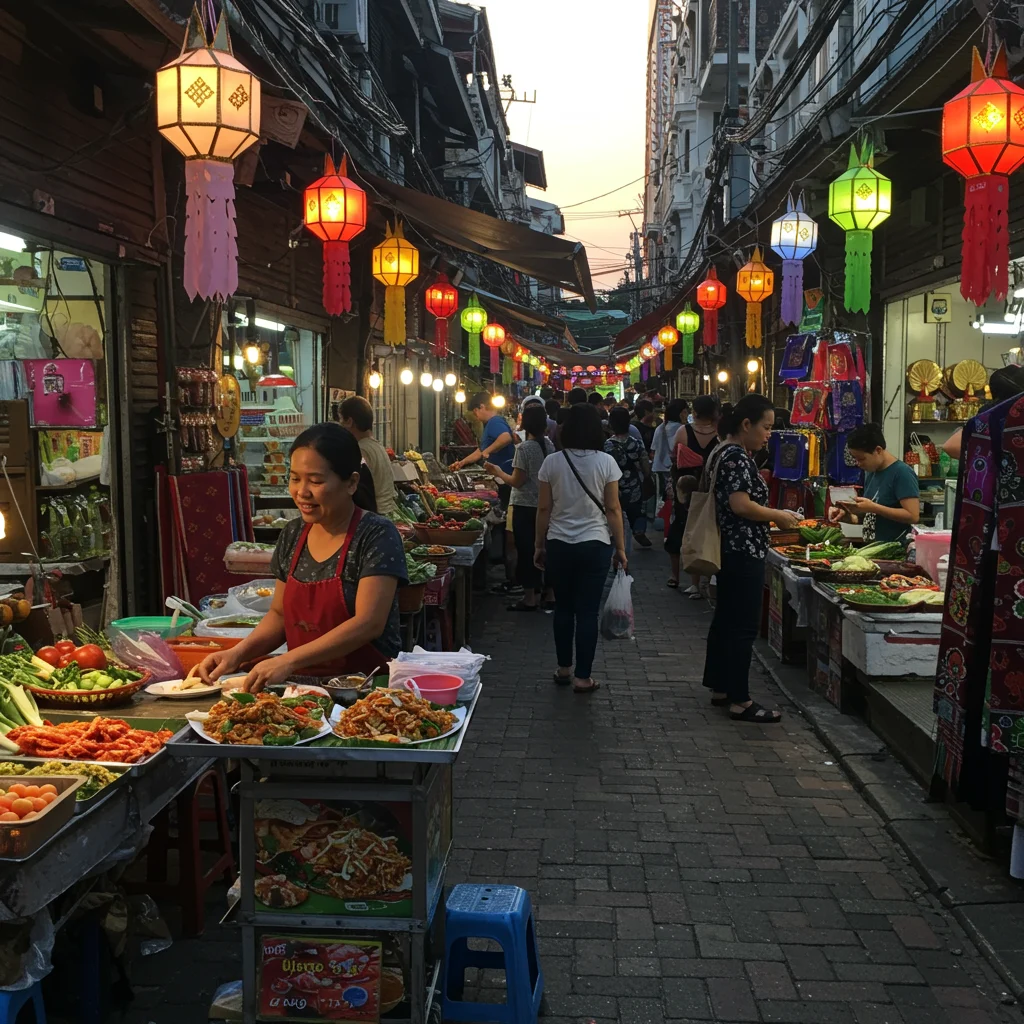
Vendors call out friendly greetings, stalls overflow with colorful wares, and the aroma of fresh street food fills the air. Unlike modern shopping centers, Sampheng retains an old-world charm, where bargaining is an art and personal connections matter.
A Brief History of Sampheng Market
The story of Sampheng Market stretches back to the late 18th century, shortly after Bangkok became Thailand’s capital. Originally established by Chinese immigrants, it quickly grew into a vital trading hub. Over the decades, it has witnessed waves of change, from colonial trade to the rise of modern commerce, yet it remains rooted in tradition.
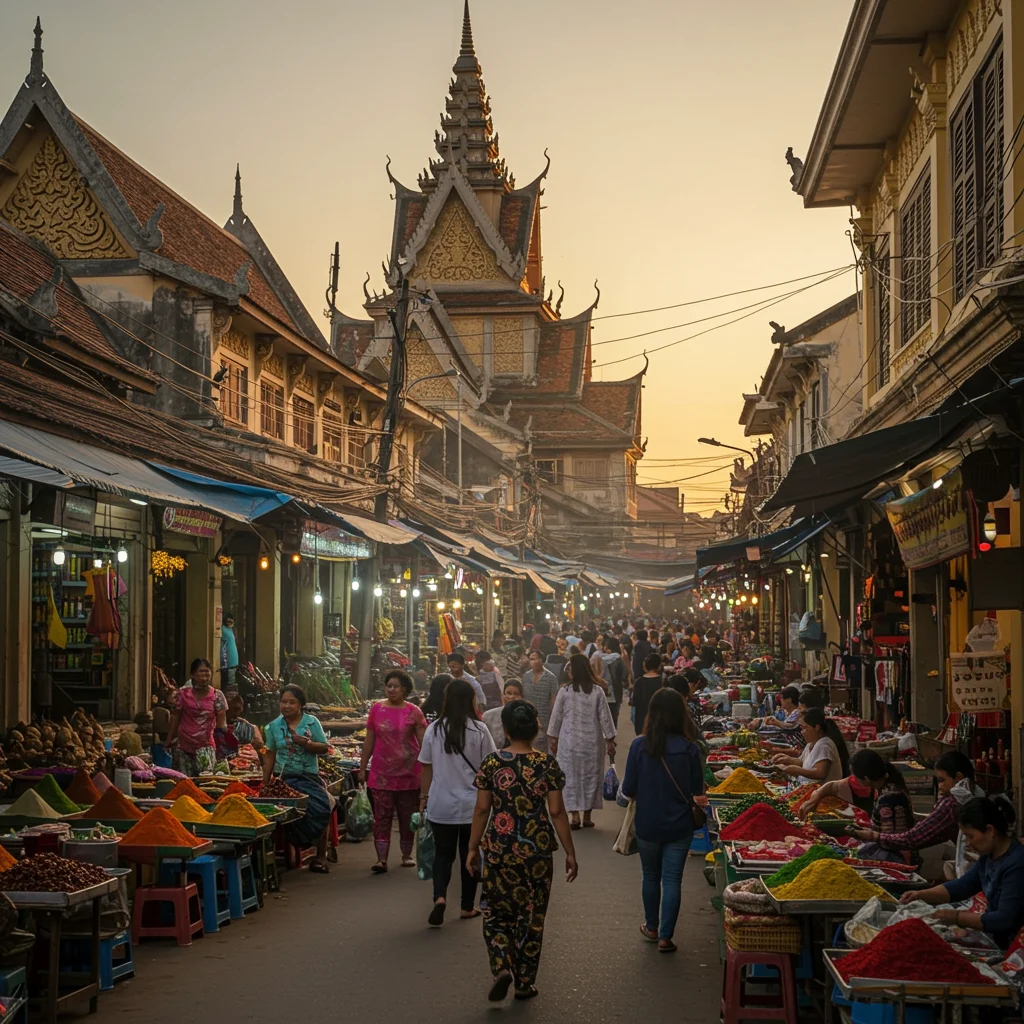
Today, Sampheng is considered the historic heart of Bangkok’s Chinatown, a place where heritage and commerce intertwine. Its legacy lives on in the bustling trade, intricate alleyways, and enduring community spirit.
Where Is Sampheng Market Located?
Sampheng Market is centrally located in Bangkok’s Chinatown, specifically along Soi Wanit 1. The market snakes through a labyrinth of lanes between Yaowarat Road and Charoen Krung Road. Its location makes it easily accessible from several key parts of the city, drawing both locals and visitors seeking authentic goods and experiences.
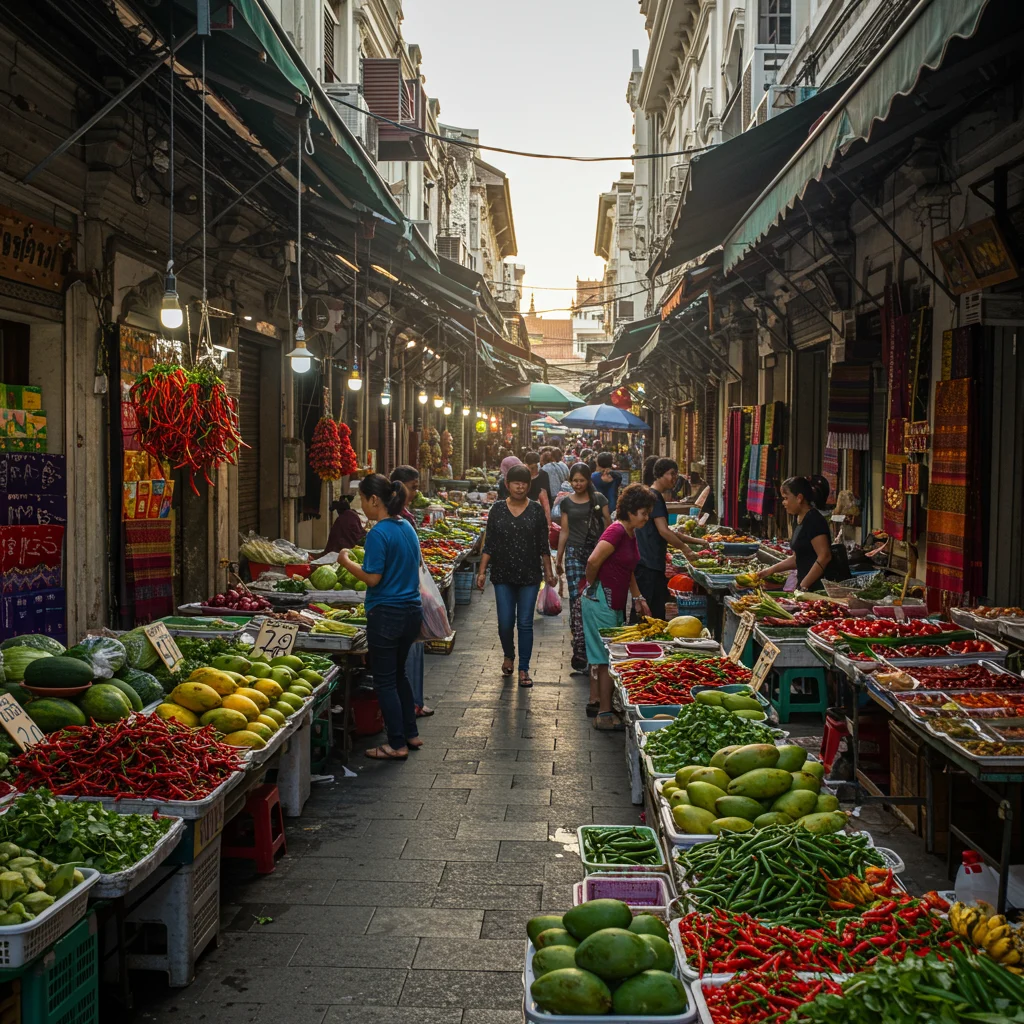
The surrounding neighborhood is lively and full of character, with temples, shrines, and historic buildings nearby. This proximity allows for a seamless blend of shopping and cultural exploration.
How Can You Get to Sampheng Market?
Reaching Sampheng Market is straightforward, thanks to Bangkok’s excellent transportation network. Visitors can take the MRT to Hua Lamphong Station and walk, or use buses and taxis that drop off at the edges of Chinatown. For those seeking a more local experience, river ferries along the Chao Phraya can also provide scenic access to the market area.
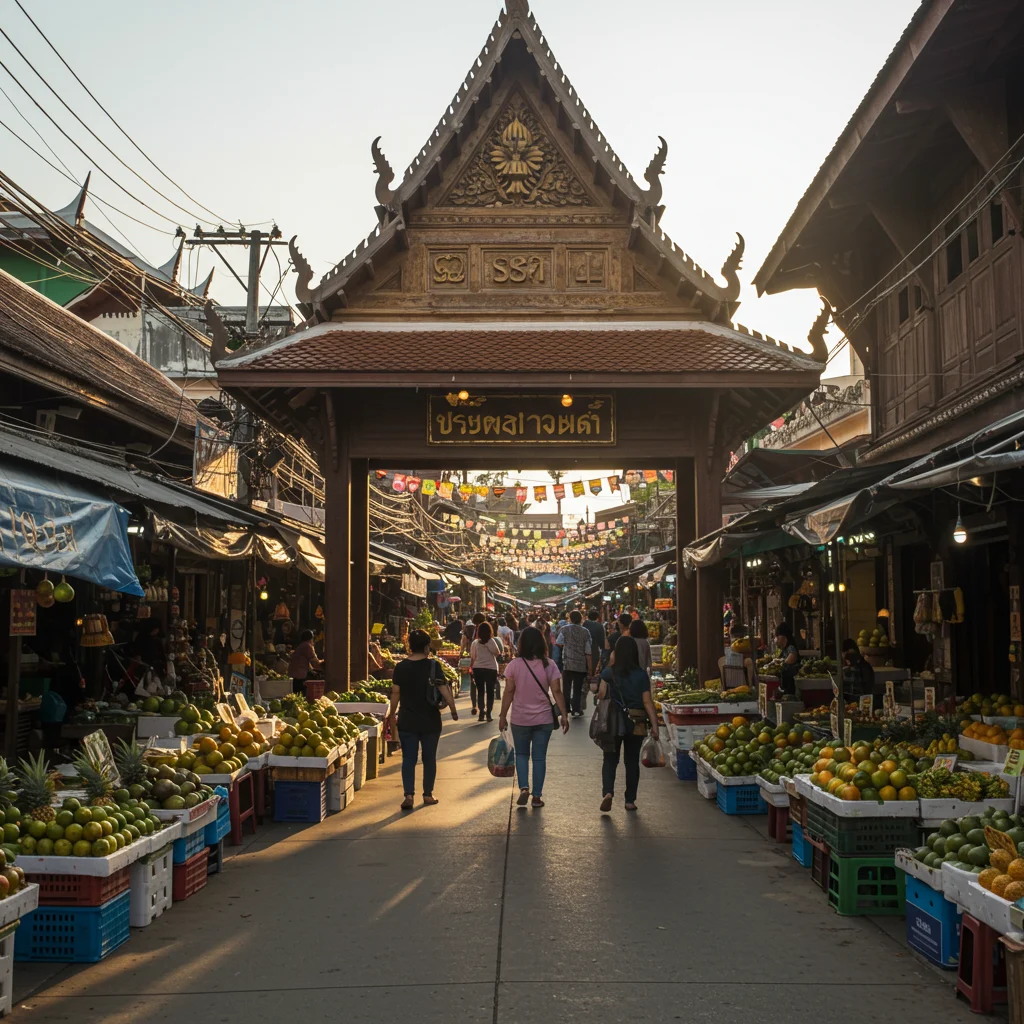
Some travelers enjoy the excitement of a tuk-tuk ride through the city’s bustling streets. This mode of transport, with its open-air design and lively pace, offers a memorable way to arrive—similar to what we discussed in our feature about the Tuk Tuk Bucharest Private Tour.
When Is the Best Time to Visit Sampheng Market?
The most comfortable time to visit Sampheng Market is in the morning, when temperatures are cooler and the crowds are thinner. The market typically opens early, with vendors setting up stalls before sunrise. By midday, the narrow lanes become packed, and the heat intensifies, which can make shopping less enjoyable.
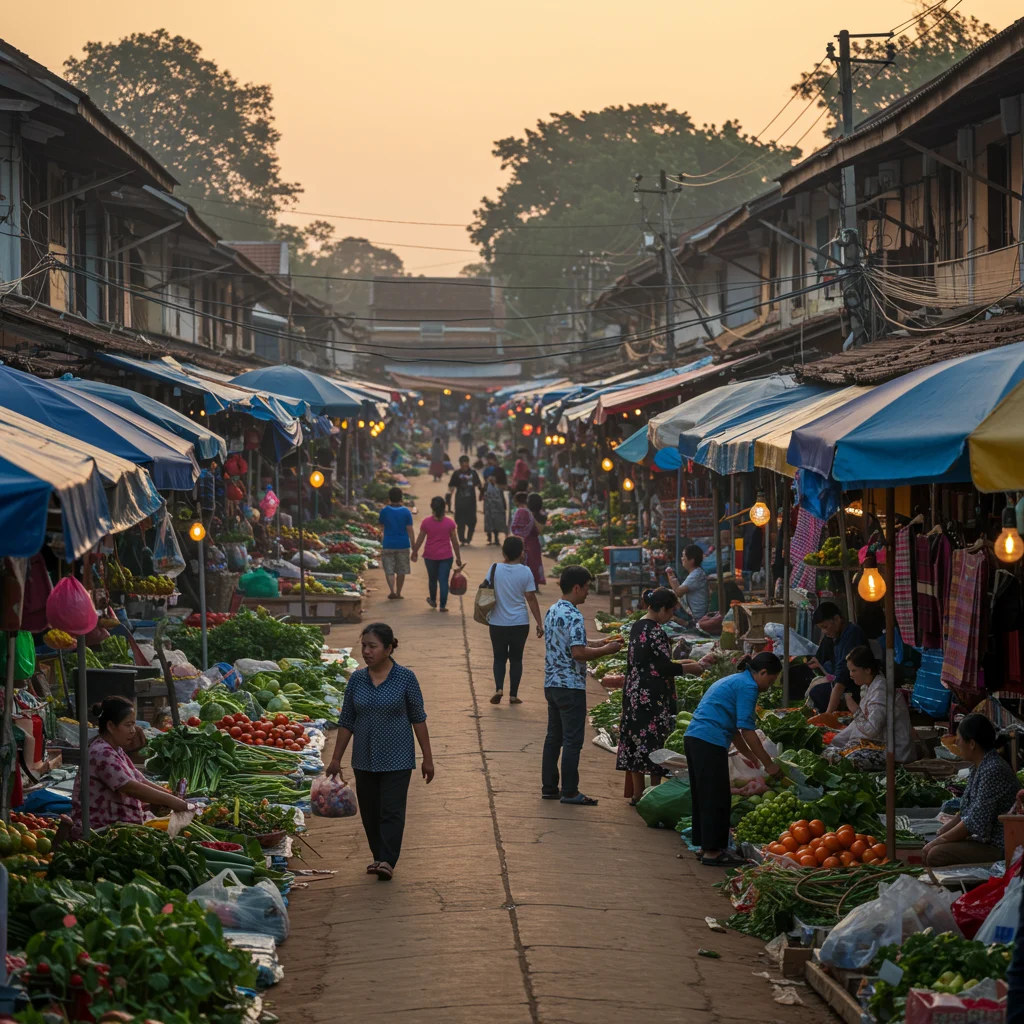
Weekdays are generally quieter than weekends, offering a more relaxed atmosphere. If you seek bargains and prefer to browse at a leisurely pace, arriving early is always advisable.
How Can You Understand the Layout of Sampheng Market?
Sampheng Market is famously intricate, with its network of tight alleys and passageways. The market stretches for about one kilometer, lined with hundreds of stalls selling everything from fabrics to toys. Understanding the layout can help us navigate efficiently and make the most of our time.
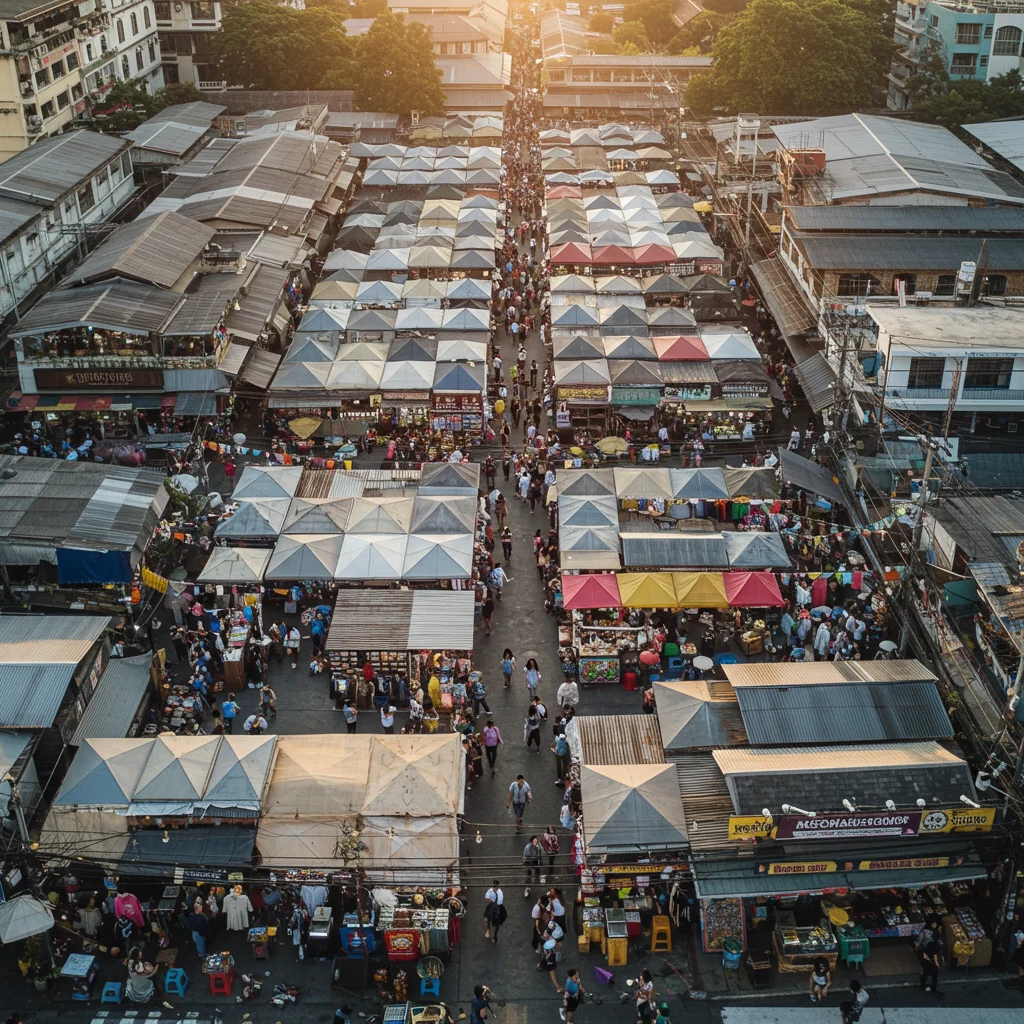
The market is divided into several zones, each specializing in particular goods. Familiarizing ourselves with these areas ensures we do not miss out on hidden gems or must-have items.
Navigating Sampheng’s Maze-Like Lanes
The alleys of Sampheng Market are famously narrow, often just wide enough for two people to pass. Vibrant awnings and hanging merchandise create a patchwork of color overhead, while the constant flow of shoppers and porters adds to the lively energy.
Signage can be limited, so we recommend noting key landmarks—such as side streets and major intersections—to avoid getting disoriented. Maps and translation apps can also be helpful companions.
What Are the Key Sections and Zones Within the Market?
Each section of Sampheng Market has its specialty. Some areas brim with fabrics and textiles, while others focus on jewelry, toys, or home goods. The market is loosely organized by product type, but stalls often overlap, creating an eclectic mix.
- The textile zone offers both traditional Thai fabrics and modern prints.
- The stationery section features endless rows of colorful pens, notebooks, and art supplies.
- Home goods and kitchenware are concentrated near the market’s eastern end.
- Toys and seasonal gifts pop up throughout, especially near major holidays.
What Can You Buy at Sampheng Market?
One of the joys of Sampheng Market is the sheer variety of goods on offer. Shoppers can find everything from fashion items and craft supplies to homeware, souvenirs, and playful gifts—all at highly competitive prices.
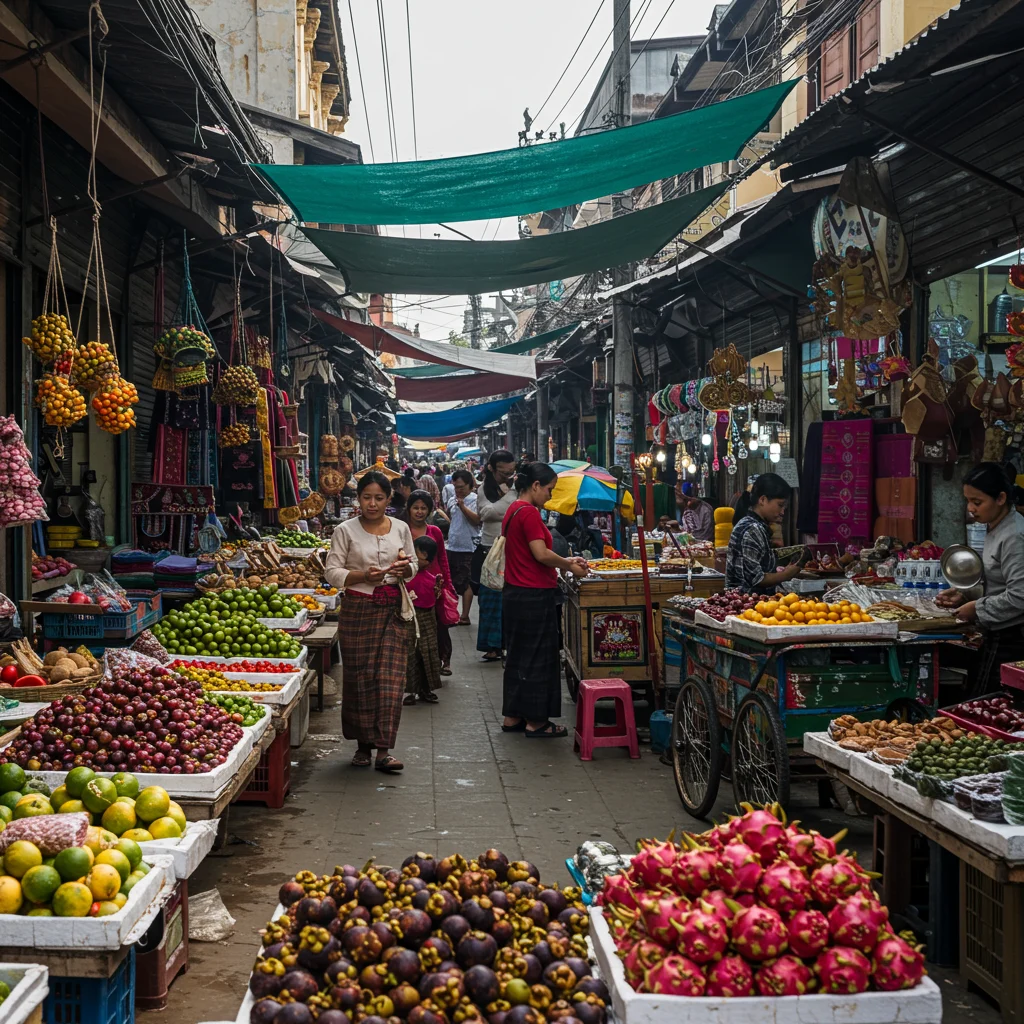
Whether you are searching for everyday essentials or unique keepsakes, the market caters to every taste and budget.
Fashion Finds: Clothing and Accessories
Sampheng is a treasure trove for those seeking affordable clothing and accessories. Trendy styles, classic pieces, and traditional garments line the stalls, often at wholesale prices.
Accessories are especially popular, with countless options for personalizing your look or finding the perfect gift.
Jewelry and Accessories Galore
Stalls overflow with costume jewelry, hair clips, belts, and more. Shimmering bangles, beaded necklaces, and quirky earrings catch the light and the eye. Many vendors also offer bulk discounts for those willing to purchase multiple items.
Traditional Thai Fabrics and Textiles
Rows of stalls display brilliantly colored Thai silk, cotton, and batik fabrics. The tactile appeal of these textiles—smooth, soft, intricately patterned—makes them irresistible. Whether for sewing projects or as souvenirs, these fabrics reflect the artistry of local weavers.
Trendy Bags and Shoes
Sampheng’s selection of bags and shoes caters to every style and age group. From playful backpacks to elegant handbags and comfortable sandals, shoppers enjoy a wide assortment of designs and materials.
Stationery and Craft Supplies
For lovers of stationery and crafts, Sampheng is a paradise. The stationery section dazzles with its rainbow-hued notebooks, pens, stickers, and art materials.
Many visitors come specifically to stock up on party decorations, DIY kits, and school supplies, drawn by the variety and affordability.
Party Favors and Decorations
Stalls specializing in party goods offer everything from balloons and banners to themed tableware. The festive atmosphere is palpable, especially ahead of major holidays and celebrations.
Scrapbooking and Art Materials
Art lovers will appreciate the abundance of scrapbooking paper, washi tape, stamps, and markers. These supplies are perfect for personal projects or creative gifts, and the sheer range sparks inspiration.
Home Goods and Souvenirs
Sampheng’s home goods section is filled with practical and decorative items that bring a touch of Thailand into any space. Shoppers can browse kitchenware, small appliances, and distinctive souvenirs.
The market’s souvenirs are especially appealing for those wishing to bring home a piece of local culture.
Kitchenware and Household Items
From gleaming stainless steel utensils to colorful ceramic bowls, the kitchenware stalls are a delight for home cooks. Many items are unique to Thailand, making them both useful and distinctive gifts.
Unique Thai Souvenirs
Handcrafted trinkets, carved wooden figurines, and traditional ornaments fill the shelves. These souvenirs capture the artistic heritage of the region and offer a meaningful alternative to mass-produced goods.
Toys and Gifts for All Ages
Children and adults alike will find plenty to enjoy among Sampheng’s toy stalls. Classic games, plush animals, and novelty gadgets abound. The playful energy of this section is infectious, with toys often displayed in bright, cheerful arrangements.
Wholesale vs. Retail: How Does Shopping Work at Sampheng Market?
Sampheng Market is renowned for its wholesale pricing, making it a favorite among shop owners and savvy locals. Many vendors offer both wholesale and retail sales, with significant discounts for bulk purchases.
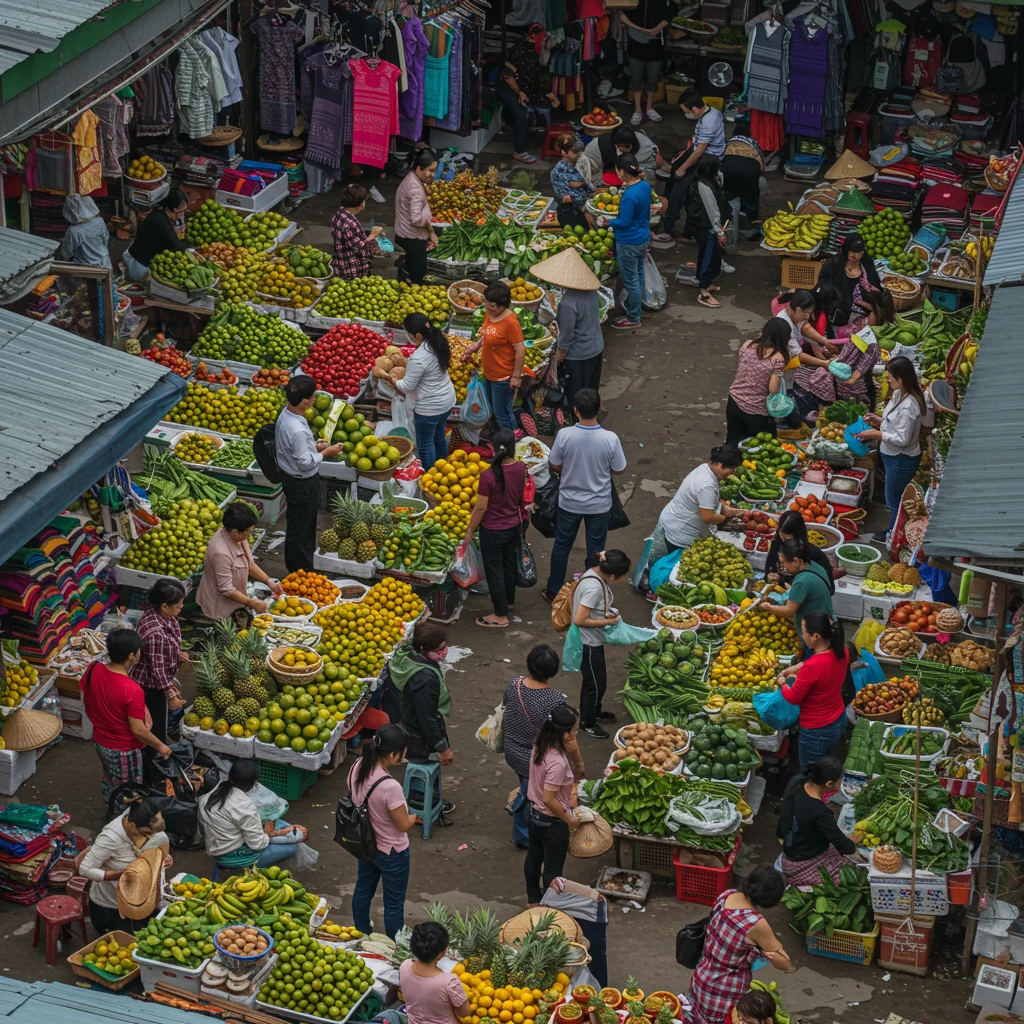
Understanding the difference between these two shopping modes can help maximize savings and ensure you get the best value.
Tips for Buying in Bulk Like a Local
To take advantage of wholesale prices, it is common to buy a minimum quantity—often three, six, or twelve pieces. Vendors will typically display the required amount or mention it when asked.
- Check with the seller about bulk discounts before making a purchase.
- Consider teaming up with friends to share larger quantities and savings.
- Be polite and patient, as negotiating is part of the process.
How to Spot the Best Deals
The best deals often require a keen eye and willingness to compare prices between stalls. Look for signs advertising promotions, and do not hesitate to ask about special offers. Experienced shoppers know that prices may vary for similar items, so a bit of browsing pays off.
For those interested in exploring markets elsewhere, our coverage of day trip markets near Ahmedabad offers additional insights into finding bargains.
What Is the Food Scene Like at Sampheng Market?
The food scene at Sampheng Market is as lively as its shopping. The market is lined with food stalls selling classic Thai dishes, quick snacks, and refreshing drinks. Aromas of grilled meats, sweet desserts, and spicy curries mingle in the air, tempting shoppers at every turn.
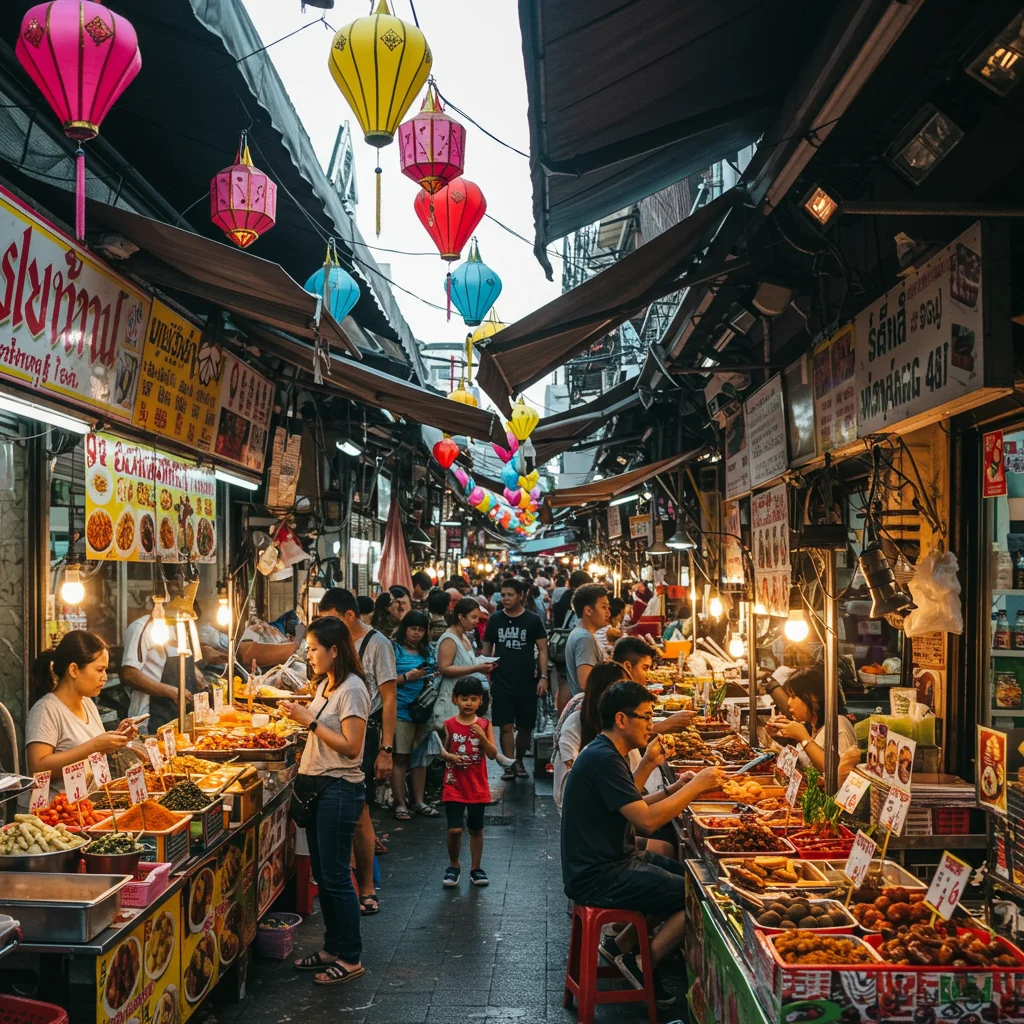
Sampling the market’s food is essential for a complete local experience, offering a delicious break from shopping and a chance to savor authentic flavors.
Street Food Stalls You Can’t Miss
Vendors prepare a dazzling array of street foods right before your eyes. The sizzle of stir-fries, the snap of fresh fruit being sliced, and the inviting warmth of steaming noodle bowls all contribute to the market’s energetic atmosphere.
Must-Try Traditional Thai Snacks
We recommend sampling snacks like kanom krok (coconut rice pancakes), moo ping (grilled pork skewers), and tod man pla (fish cakes). Each bite delivers a burst of authentic flavor and texture.
Refreshing Drinks and Desserts
Cool off with icy drinks such as cha yen (Thai iced tea) or fresh coconut water. For dessert, try mango sticky rice or sweet roti, which are both beloved by locals and visitors alike.
Where to Rest and Refuel
When the bustle becomes overwhelming, there are plenty of places nearby to sit and recharge. Small cafés and casual eateries surround the market, offering everything from hearty noodle soups to aromatic coffee.
Local Eateries and Cafés Nearby
Many family-run restaurants serve classic Chinese-Thai cuisine, perfect for a leisurely lunch. The air is often filled with the fragrance of freshly steamed dumplings and rich broths.
Hidden Food Gems in the Market
Some of the best meals are found tucked away in the market’s quieter corners. Look for spots where locals queue up—these hidden gems often serve unforgettable specialties at unbeatable prices.
How Can You Bargain Like a Local at Sampheng Market?
Bargaining is a regular part of shopping at Sampheng Market. Vendors expect some negotiation, and with a friendly approach, both parties can walk away satisfied. Mastering a few key techniques makes the process enjoyable and rewarding.
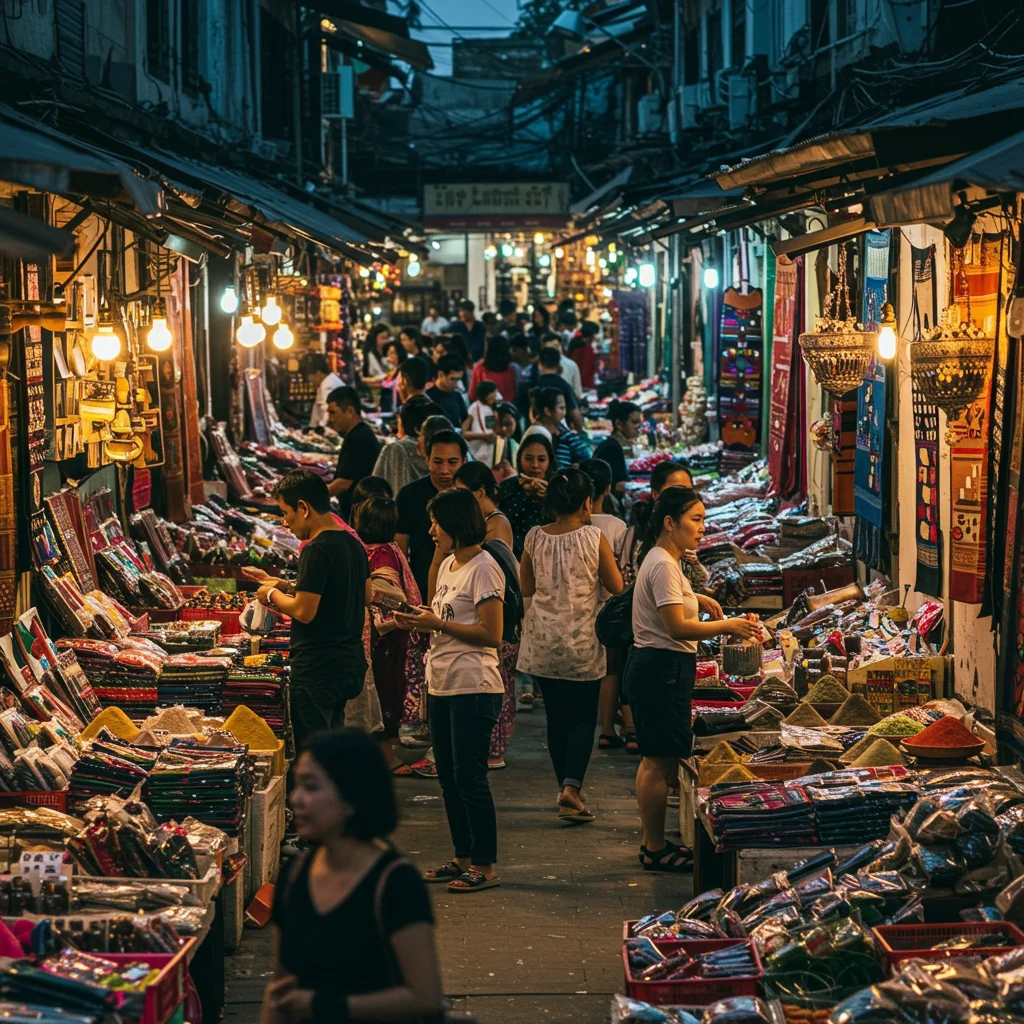
As experts often say:
“Effective bargaining is not just about getting the lowest price—it’s about building rapport, showing respect, and finding a deal that works for everyone.”
Essential Thai Phrases for Shoppers
Learning a few simple Thai phrases can go a long way in creating goodwill and improving your bargaining power. Common phrases include:
- “Tao rai?” (How much?)
- “Lot dai mai?” (Can you discount?)
- “Paeng pai” (Too expensive)
- “Khob khun” (Thank you)
What Is the Cultural Etiquette When Haggling?
Maintaining politeness and a sense of humor is key. Smiling, using gentle language, and avoiding confrontation helps build trust. Vendors appreciate respectful negotiation and may be more inclined to offer a better price.
Dos and Don’ts of Negotiating Prices
- Do: Offer a reasonable counter-offer, based on your research.
- Do: Thank the vendor, even if you do not make a purchase.
- Don’t: Insist on an unreasonably low price or become argumentative.
- Don’t: Forget to carry small bills for easier transactions.
What Payment Methods Are Accepted?
Sampheng Market remains a predominantly cash-based environment, though some vendors accept mobile payments and cards. Understanding your payment options will help avoid any inconvenience.
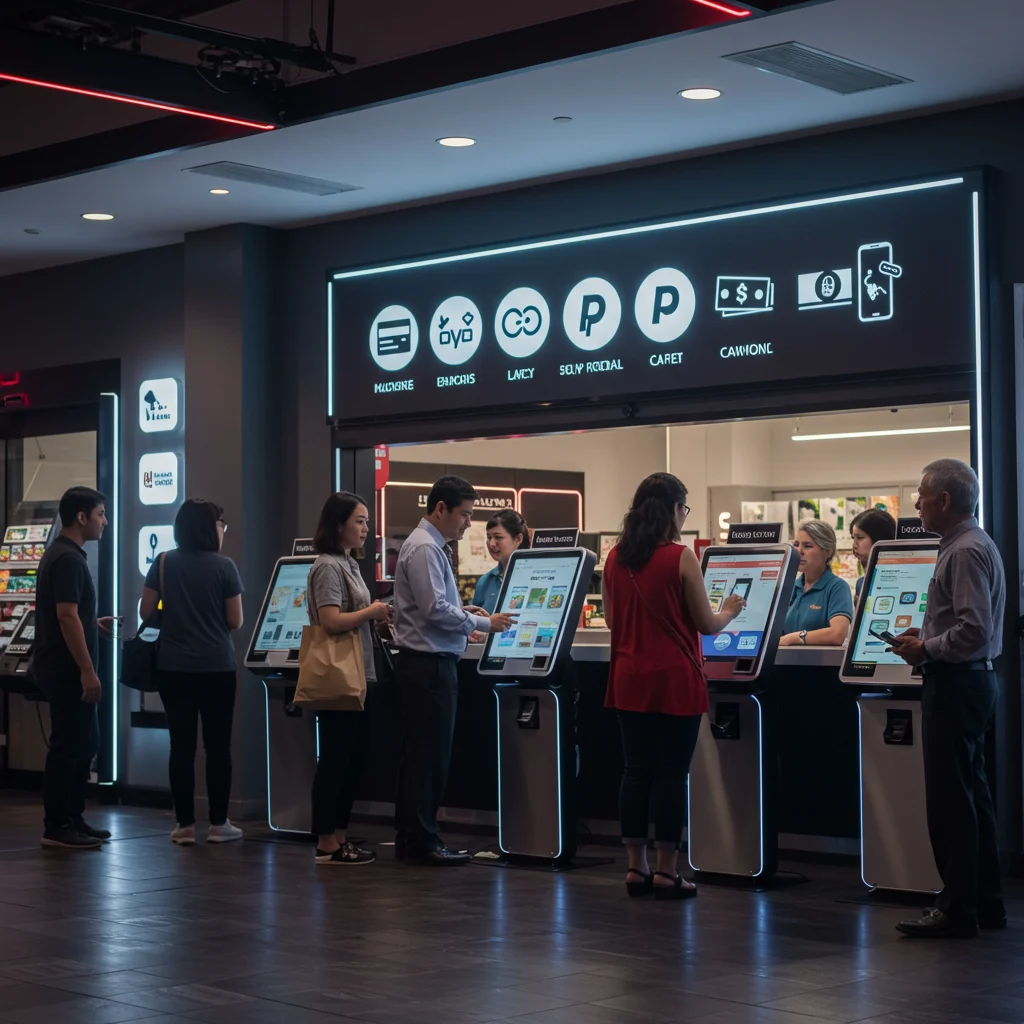
It is wise to prepare your payment method in advance, especially during busy periods.
Cash vs. Card: What Should You Bring?
Bringing sufficient cash—preferably in small denominations—is essential. While a handful of larger shops accept credit cards or mobile payments, most stalls do not. Carrying cash ensures smooth transactions and helps when negotiating prices.
Are There ATMs and Money Exchange Options Nearby?
ATMs are readily available around the perimeter of Sampheng Market, as are currency exchange booths. Be cautious when withdrawing cash and store it securely.
How Can You Stay Safe and Comfortable While Shopping?
With its bustling crowds and tight spaces, Sampheng Market can be overwhelming, especially during peak hours. A few simple precautions can make your visit more enjoyable and stress-free.
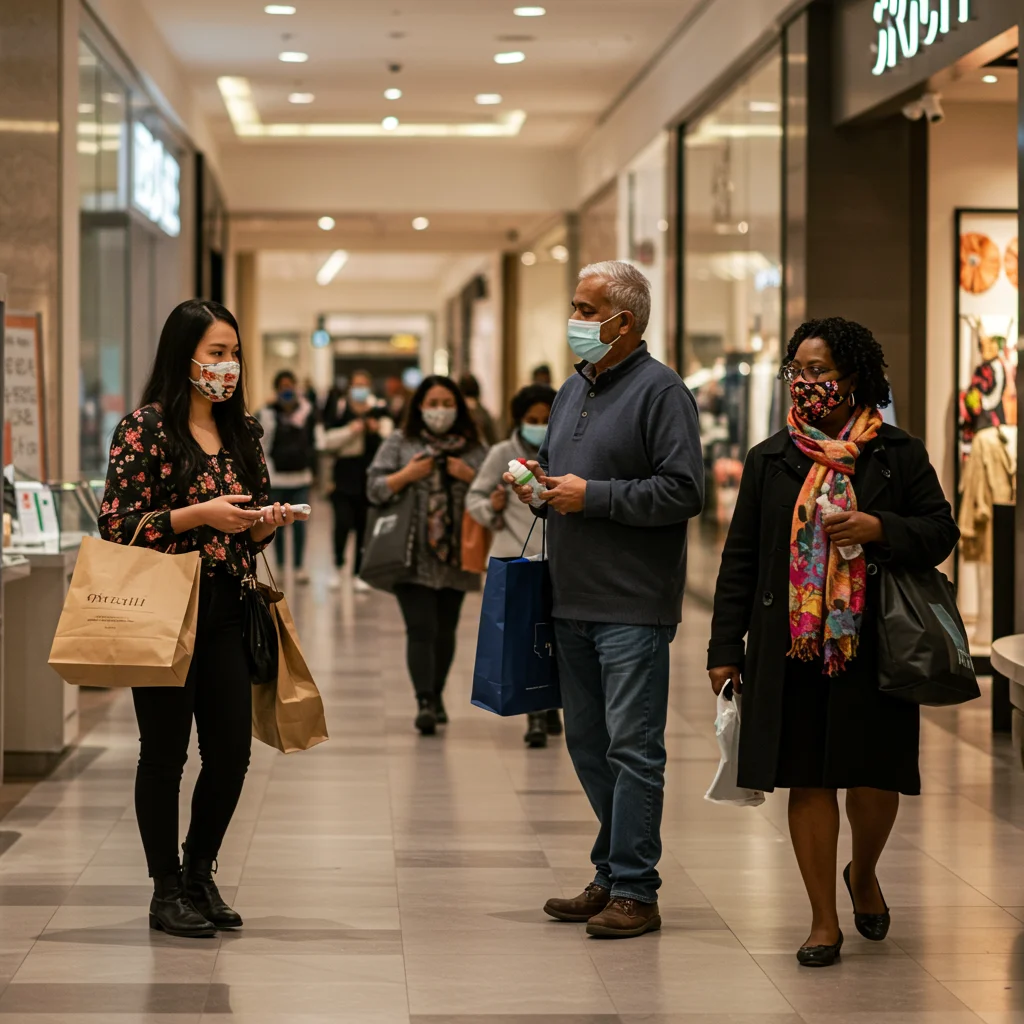
Staying alert, dressing comfortably, and keeping your belongings close are all important steps to consider.
Dealing with Crowds and Narrow Walkways
The market’s narrow aisles can become congested quickly. Move at a relaxed pace, step aside for porters with handcarts, and avoid blocking thoroughfares. Patience and courtesy go a long way in these close quarters.
How Can You Protect Your Belongings?
Pickpocketing is uncommon but possible in crowded areas. Use a crossbody bag that zips closed, and keep valuables in front of you. Avoid carrying unnecessary items, and be discreet when handling money.
Weather Tips: What Should You Wear?
Bangkok’s weather is hot and humid for most of the year. Lightweight, breathable clothing is ideal, along with comfortable shoes for walking. A hat, sunscreen, and a reusable water bottle help you stay cool and hydrated.
On rainy days, a compact umbrella or raincoat is recommended, as the market offers limited shelter.
Is Sampheng Market Kid-Friendly for Families?
Sampheng Market can be a lively adventure for families with children. While the crowds and narrow aisles require extra attention, the variety of toys, snacks, and colorful sights make it an engaging experience for all ages.
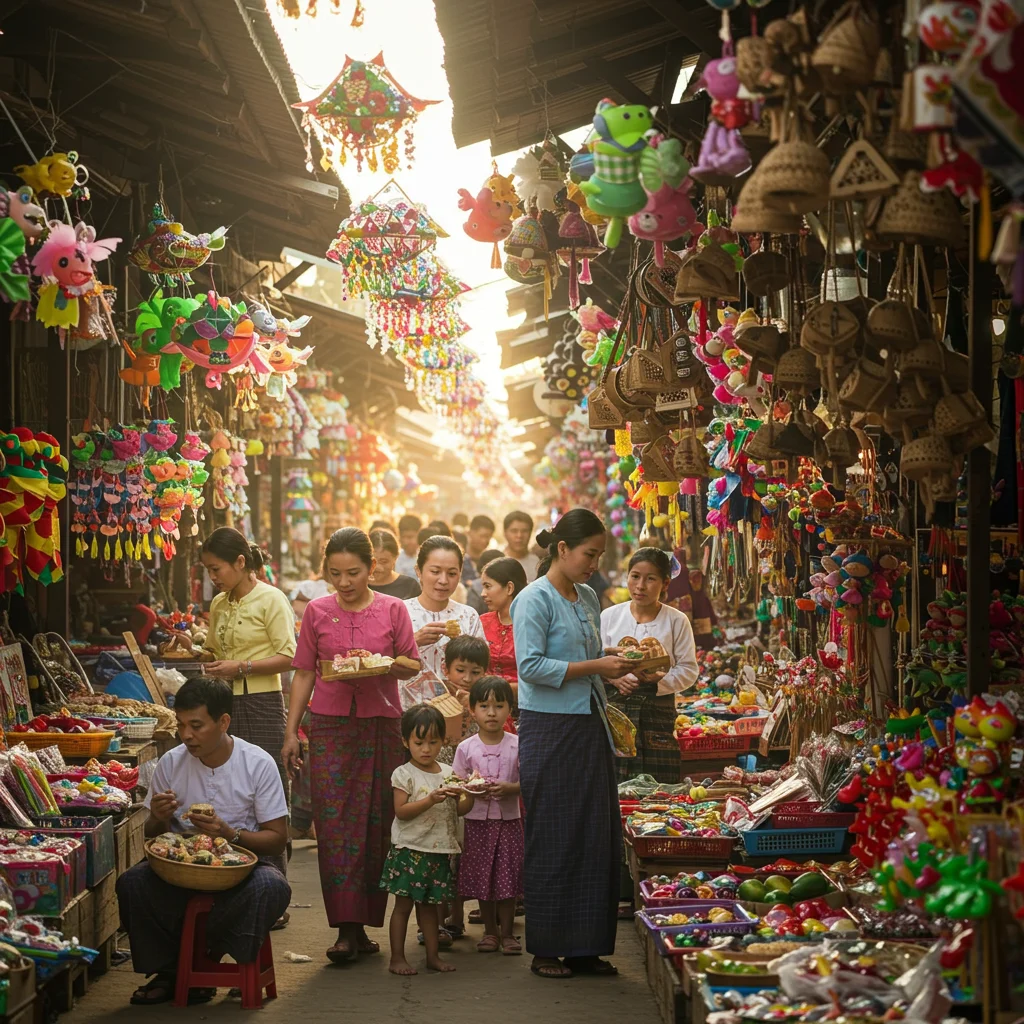
Planning ahead and knowing the available facilities can help families enjoy a smooth visit.
Facilities for Children and Families
Some areas of the market offer stroller-friendly paths, though many lanes are challenging to navigate with large prams. Consider using a baby carrier or lightweight stroller for easier movement.
Restroom Availability and Cleanliness
Public restrooms are available at the edges of the market and in nearby shopping centers. Facilities are generally clean, but carrying tissues and hand sanitizer is advisable, especially when visiting with young children.
Can Everyone Enjoy Accessibility at Sampheng Market?
Accessibility is gradually improving at Sampheng Market, though the historic layout and narrow lanes present challenges. With some planning, visitors with mobility needs can still have a fulfilling experience.
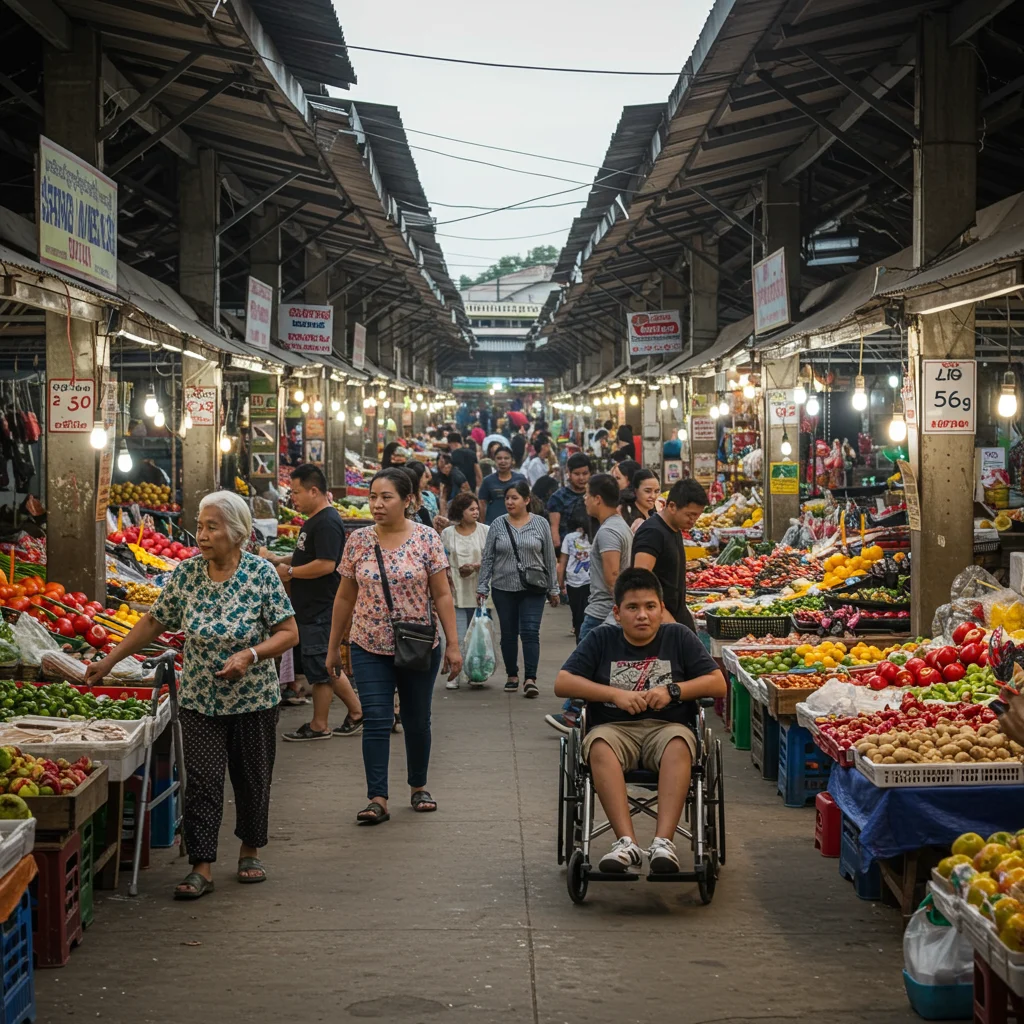
Awareness of support options and alternative routes is key for a comfortable visit.
Is There Wheelchair and Stroller Access?
While some main walkways are accessible, many alleys are too narrow or uneven for wheelchairs and large strollers. The surrounding streets, however, offer easier access, and some vendors will accommodate shoppers outside their stalls.
What Support Exists for Elderly Shoppers?
Elderly visitors may appreciate the slower pace of early mornings, as well as the availability of benches and shaded areas nearby. Bringing a companion can also enhance safety and enjoyment.
What Are Sustainable and Responsible Shopping Tips?
Shopping responsibly at Sampheng Market benefits both the environment and the local community. Small changes in our habits can make a positive impact, ensuring the market remains vibrant for future generations.
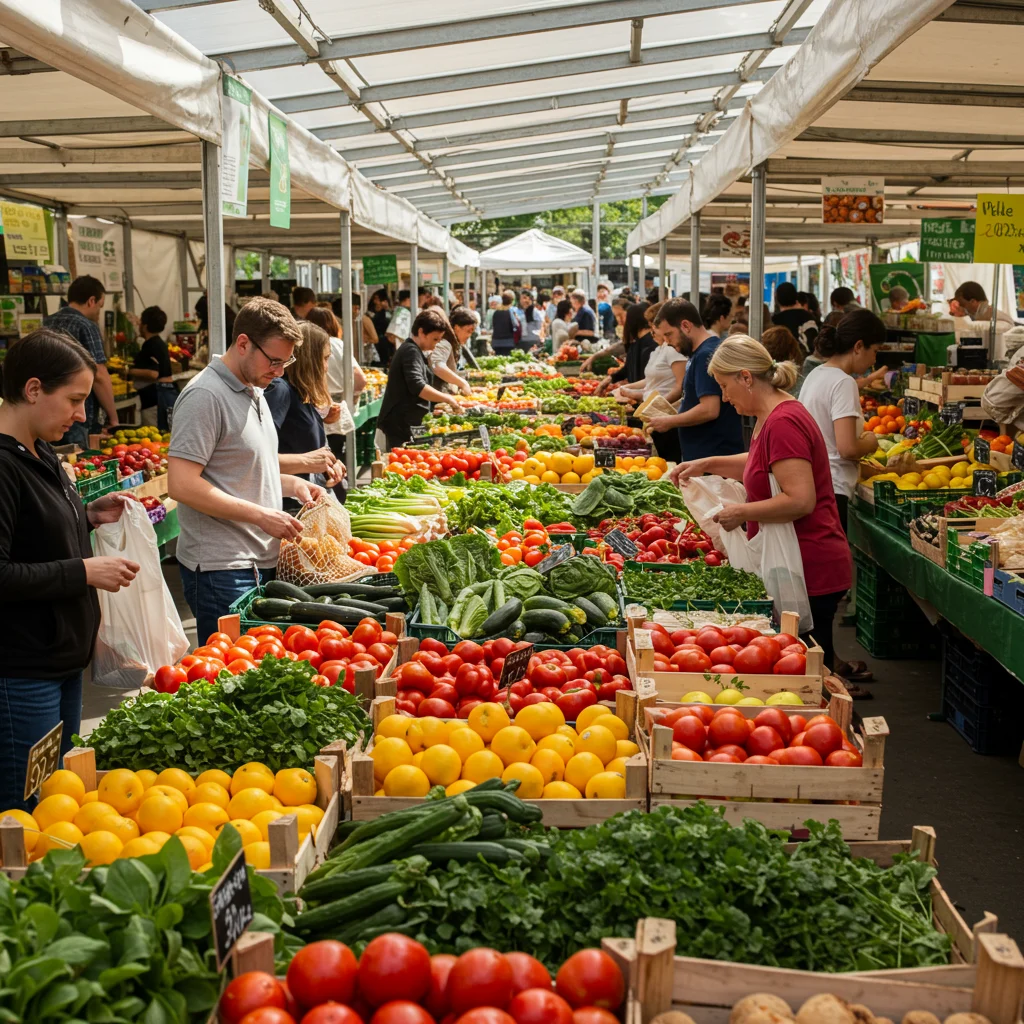
We can take inspiration from sustainable travel experiences worldwide, such as those highlighted in our review of farm life near Karachi, where supporting local producers is central.
How Can You Reduce Plastic Waste While Shopping?
- Bring reusable shopping bags and containers for food items.
- Politely decline extra packaging when possible.
- Choose vendors who use minimal or eco-friendly packaging.
How to Support Local Vendors and Artisans
- Buy directly from small stalls and family-run businesses.
- Seek out handmade or locally produced goods.
- Share positive feedback and recommend favorite vendors to others.
Can You Take Pictures at Sampheng Market?
Photography is generally welcomed at Sampheng Market, though it is important to respect vendors’ privacy and local customs. The market’s dynamic atmosphere and colorful displays provide ample opportunities for memorable photos.
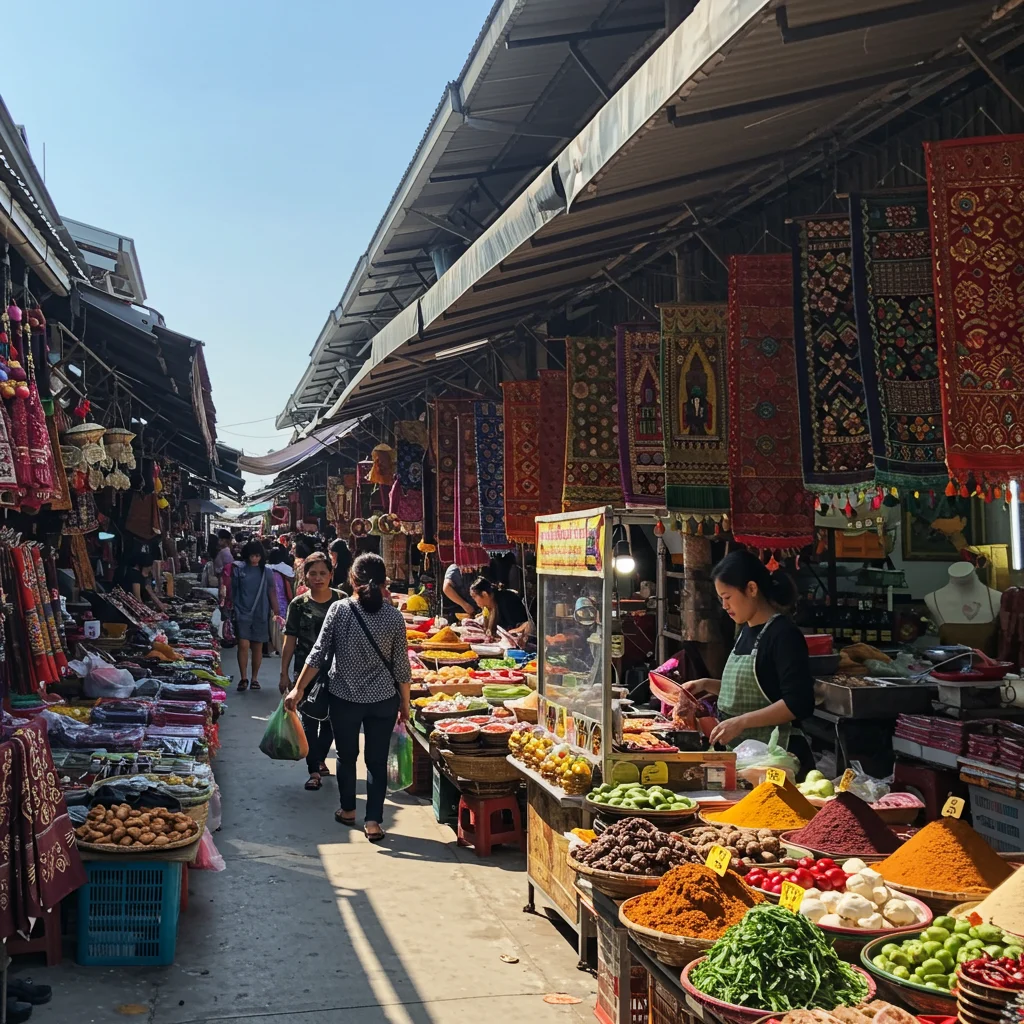
Capturing the essence of the market requires both creativity and sensitivity to those around you.
What Are the Best Photo Spots in Sampheng Market?
Look for bustling intersections, vibrant fabric stalls, and food vendors preparing dishes in the open. The interplay of light, color, and activity creates striking images that reflect the energy of the market.
If you appreciate photographing cultural landmarks, you may also enjoy our illustrated guide to Angkor Wat’s iconic temple complex.
How to Respect Vendor Privacy
Always ask permission before photographing individuals or their merchandise. A smile and polite gesture are usually sufficient, and most vendors are happy to oblige if approached respectfully.
What Are the Nearby Attractions to Explore After Shopping?
Once you have finished shopping at Sampheng Market, the surrounding Chinatown district offers a wealth of attractions. From historic temples to other lively markets, there is much to see and experience nearby.
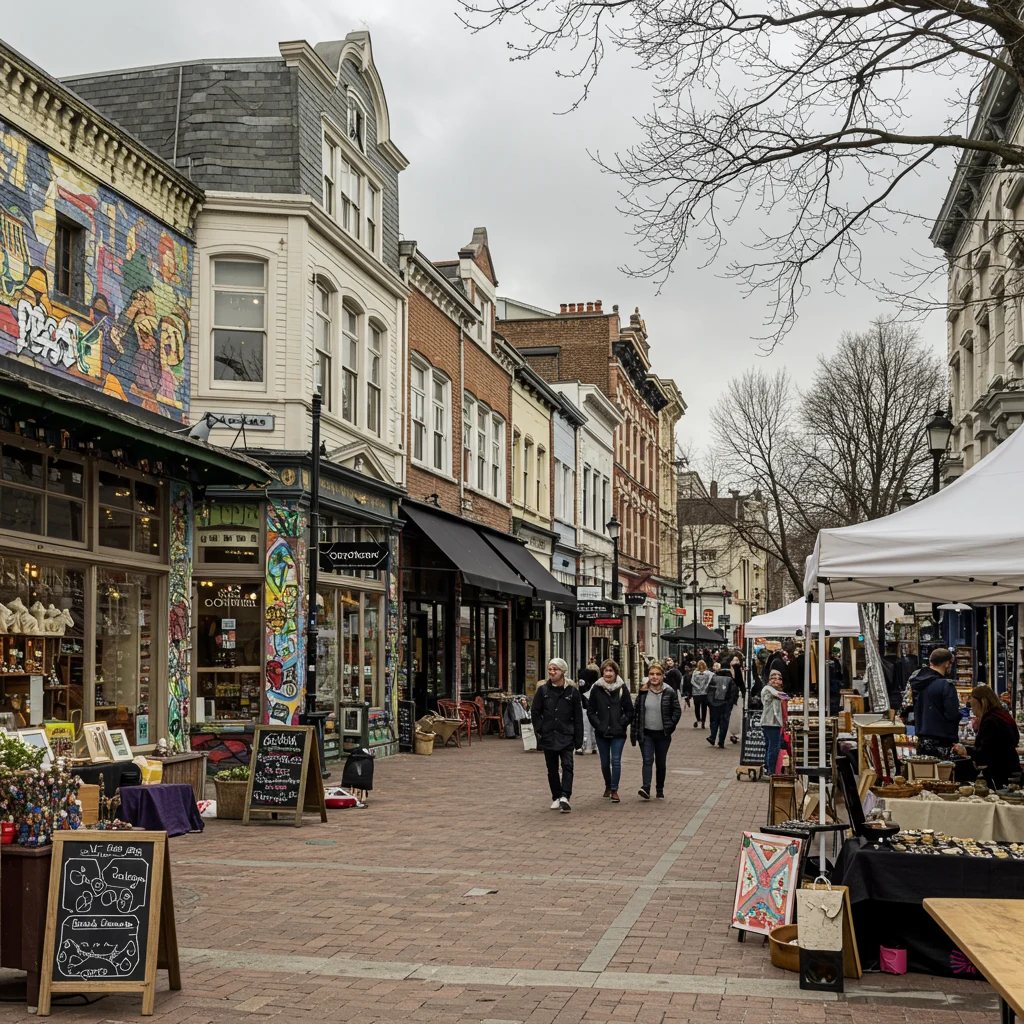
Many visitors spend the day exploring these sights, making the most of their time in this fascinating part of Bangkok.
Chinatown’s Temples and Shrines
Wat Mangkon Kamalawat, Bangkok’s largest Chinese Buddhist temple, is just a short walk away. The temple’s intricate carvings, fragrant incense, and tranquil courtyards provide a peaceful counterpoint to the market’s energy.
Smaller shrines and historic landmarks dot the neighborhood, inviting quiet moments of reflection and cultural appreciation.
Other Markets Worth Visiting
Bangkok is famous for its diverse markets. After Sampheng, consider visiting the nearby Talat Noi or Pak Khlong Talat, the city’s renowned flower market. Each destination offers its own distinctive atmosphere and specialties.
For those who enjoy themed tours, experiences like the Belfast Black Taxi Tours demonstrate how local guides can provide unique perspectives on a city’s life and history.
Where Should You Stay Near Sampheng Market?
The Chinatown area surrounding Sampheng Market offers a range of accommodation options, from budget guesthouses to boutique hotels. Staying nearby allows easy access to the market and the district’s rich cultural offerings.

Selecting the right place to stay depends on your preferences for location, amenities, and atmosphere.
Hotels and Guesthouses for Every Budget
Options include cozy hostels, mid-range hotels, and upscale lodgings with river views. Many properties offer easy walking access to Sampheng and other local attractions, making them convenient bases for exploration.
Tips for Booking Accommodation
- Book early during peak travel seasons to secure the best rates.
- Check reviews for cleanliness, safety, and guest satisfaction.
- Consider properties that include breakfast or shuttle service for added value.
Frequently Asked Questions About Sampheng Market
To help you plan a successful visit, we have compiled answers to the most common questions about Sampheng Market and its surroundings.
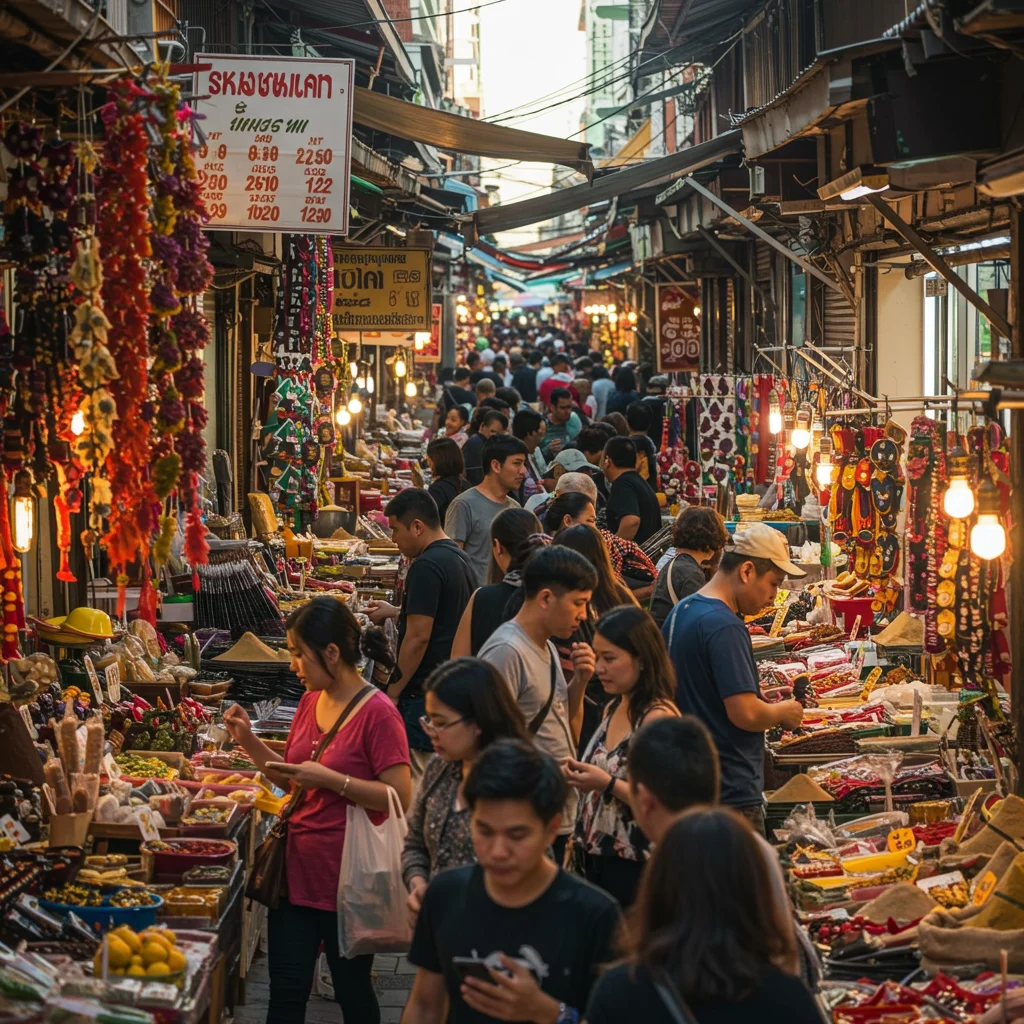
How Much Time Should You Spend at the Market?
Most visitors spend two to four hours exploring the market, though those seeking specific items or a leisurely shopping experience may stay longer. Arriving early helps maximize your time and comfort.
Is Sampheng Market Open Every Day?
Sampheng Market operates daily, typically from early morning until late afternoon. Some stalls close on major holidays, but the market is generally open year-round.
What Should You Bring With You?
- Cash in small denominations
- Reusable shopping bags
- Comfortable walking shoes
- Sun protection and water
- Translation or navigation apps
Conclusion: Making the Most of Your Sampheng Market Experience
Shopping at Sampheng Market is an invitation to connect with Bangkok’s local culture, savor authentic flavors, and find unique treasures. With a little planning and an open mind, every visit becomes a memorable adventure. For more travel inspiration, tips, and curated experiences around the world, we invite you to explore Tourlik—your guide to discovering the heart of every destination.
